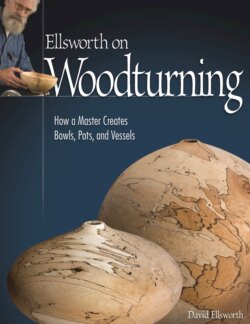Оглавление
David Ellsworth. Ellsworth on Woodturning
Preface
Acknowledgments
Table of Contents
Introduction – The Creative Process
Working with Green Wood & Dry Wood
Working green wood versus dry wood
Why work with green wood?
An extraordinary wealth of raw material
Managing Materials
Characteristics of wood
Preserving materials
Spalting wood
Working with burls
Types of burl growth
Dissecting the burl
Why Turning Tools Work
The mechanics of sharp
Cutting versus scraping
Friction and abrasion
Specific tools
Skews
Parting tools
Hollowing tools
The gouge
Making Tools & Tool Handles
Getting started
Making tool shafts
Making a bent shaft
Making a tip
Creating hollowing tools from other tools
Screwdrivers
Allen wrenches
Irish concrete nails
Shaping the bevel on repurposed tools
Making a tool handle
Turning a tool handle
Drilling a hole for the shaft
Attaching the shaft to the handle
Tying a ferrule
Marking the tool handle
Sharpening
Sharpening concepts
Body tension
The curve of sharp
Honed edge versus burr edge
Diagnosing dullness
Grinders and grinding wheels
The basic sharpening stance
Sharpening individual tools
Conventional bowl and spindle gouges
The ⅜" detail gouge
The Ellsworth Signature gouge
The parting tool
Hollowing tools
Chucks, Glue Blocks & Faceplates
Chucks
Pros of the chuck
Cons of the chuck
Mounting a piece in a chuck
Glue blocks
Pros of the glue block
Cons of the glue block
Preparing a glue block
Faceplates
Pros of the faceplate
Cons of the faceplate
Mounting a piece on a faceplate
Helpful tidbits for modifying faceplates
Design
Appreciating the process
Improving your design skills
Learning what you like
Make drawings
Make shavings
The two primary ways of designing
Designing at the beginning
Design development
Trusting your instincts
Inspiration and evolution
#1: Toward hollow forms
#2: Natural edges
#3: Form shapes and opening sizes
#4: Surface textures
#5: Recessed openings
#6: Surface enhancements
Design elements
Inlays
Charring
Color
Closing thoughts on design
The Body
The three classic body problems
Balance and support
Tension
Muscle memory
Flexion exercises
Muscle access exercises
The hanging bar
If it hurts...don’t do it
Turning an Open Bowl with a Cut Rim
Preparing the block from a log
Mounting the block on the lathe
Rough-turning the bowl using the roughing cut
The Roughing Cut
Shaping the outside of the bowl with the slicing cut
The Slicing Cut
Flattening the base using the scraping cut
The Scraping Cut
Preparing the base for attachment to the lathe
Creating a base cut
Shaping the final exterior using the slicing cut
Finishing the exterior using the shear-scraping cut
The Shear-scraping Cut
Cutting the rim using the shear-scraping cut
Roughing-out the interior using the roughing cut
The Interior Roughing Cut
Finishing the interior surface with the interior-finishing cut
The Interior-Finishing Cut
Stage 1: Safely entering the rim
Stage 2: Finishing the interior of the bowl
Removing the nib
Measuring the depth of the bowl
Turning an Open Bowl with a Natural Edge
Preparing the material
Roughing-out the form
Shear-scraping the outside surface
Roughing-out the interior
Finishing the interior
Measuring the depth of the bowl
Turning the Exterior of a Hollow Form
Mounting the wood
Turning the log into a cylinder
Flattening the ends of the log
Creating a spherical shape
Remounting the log
Aligning the pith ends
Flattening the base
Cutting the final exterior surface
Turning the Interior of a Hollow Form
Preparing to turn the interior
Preparing your body
Preparing your lathe
Using straight tools (boring bars)
Using bent tools
Selecting tools
Organizing the interior
Areas #1 and #2
Keeping the cavity cylindrical
Keeping the interior clean
Removing the nib
Continuing with Area #1
Areas #2 and #3
Measuring wall thickness
Areas #4 and #5
Area #6
Preventing vibration
Areas #7, #8, and #9
Turning Spirit Forms
Origins
Preparing to turn a spirit form
Turning the exterior
Turning the interior
Measuring wall thickness
Turning the base
Jam Chucks & Vacuum Chucks
Jam chucks
Vacuum chucks
Commercial vacuum systems
Vacuum safety
Making jam and vacuum chucks
Multi-disc faceplate system
Kiln-dried wooden chucks
Making your own vacuum system
Chuck diameter
Centering a hollow form
Centering an open bowl form
Shaping the foot
Smoothing the transition
Cutting off the nib
Undercutting the base
Sanding
Sanding traditions
When are you done?
Where do you begin?
Developments relating to sanding
My thoughts about sanding
Scratching the scratches
Chatoyance
What happens during sanding
Cool sanding
Pressure sensitive adhesive (PSA) discs
Abranet sanding discs
PSA versus Abranet
Sanding a form
Green wood and sanding
Sanding green wood
Looking for problem spots
Finishing
Trends in finishing
Influence of other media
Historical influences
Choosing a finish
Creating a singularly expressive finish
When is an object finished?
Finishing products
Oil finishes
Applying an oil finish
Spray acrylic lacquer
Sandblasting
Bleaching
Burning and burnishing
Burnishing a charred surface
Sanding a charred surface
Drying Green Wood Vessels
Discovering the free energy of green wood
How wood dries
Mass, tension, and elasticity
Species
Parts of the tree
Drying methods and tips
The brown paper bag method
The wet shavings method
The dog food bag method
The plastic bag method
The plastic sheet method
The wood sealer method
Dealing with heat checks and cracks
Dealing with varying wall thicknesses
Alternate drying methods
The real problem with drying
Teaching
Create a safe space
Know your subject
Think like a student
Tell your own story
Teaching methods
In conclusion
Glossary
Resources
